Passenger trains bring convenience to secluded scenic area while cargo service to Europe hits 100,000 milestone
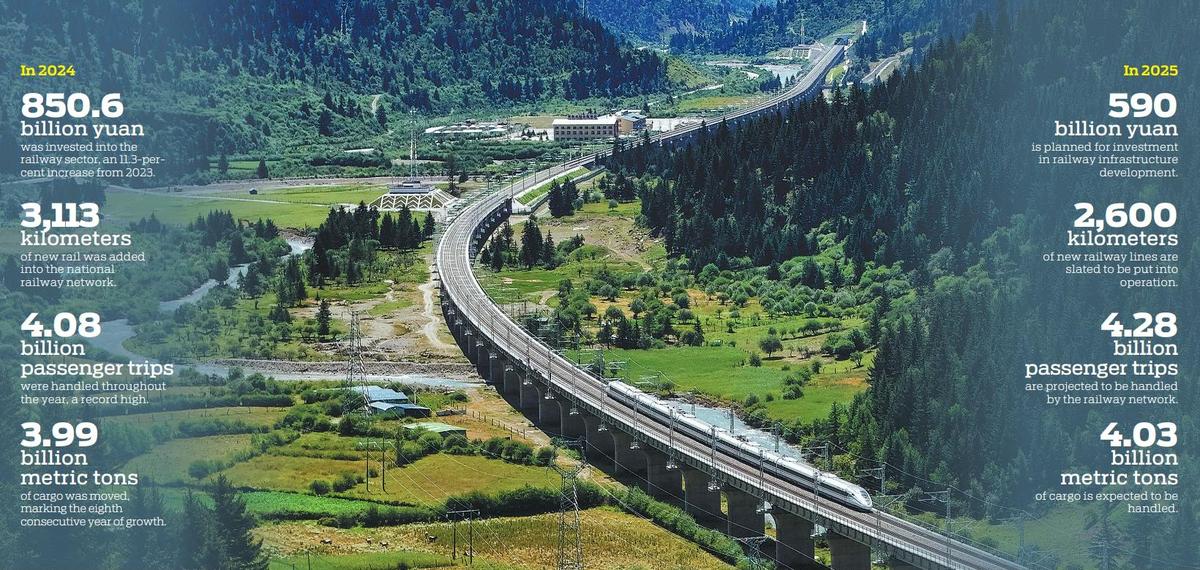
Remarkable progress was made in China's railway sector in 2024, with the improvement of the nation's transportation infrastructure contributing to economic growth and improving lives.
As of the end of last year, China's railway network had stretched to 162,000 kilometers, with 48,000 km dedicated to high-speed rail, further pressing its advantage as the global leader in high-speed rail. The network also expanded into more remote and mountainous areas, where constructing railways was once considered impossible.
Freight train services linking China and Europe saw steady growth in 2024. Launched in 2011, the total number of China-Europe freight train services surpassed 100,000 last year.
READ MORE: China's fixed-asset investment in railways hits 43.9b yuan in Jan
One of the highlights of the year was the debut of the CR450 prototypes, the next generation of high-speed trains that are faster, greener and more comfortable than those in current operation. Once they enter commercial operation, speeds will be increased to 400 km/h from the current 350km/h. This development underscores China's commitment to advancing transportation technology and improving efficiency.
China's railway freight and passenger volumes both reached record highs last year, playing a key role in supporting socioeconomic development. According to China State Railway Group, the national railway operator, in 2024, China's national railway handled a record 4.08 billion passenger trips, with daily traffic reaching a high of nearly 21.45 million. The network also moved 3.99 billion metric tons of cargo, marking the eighth consecutive year of growth.
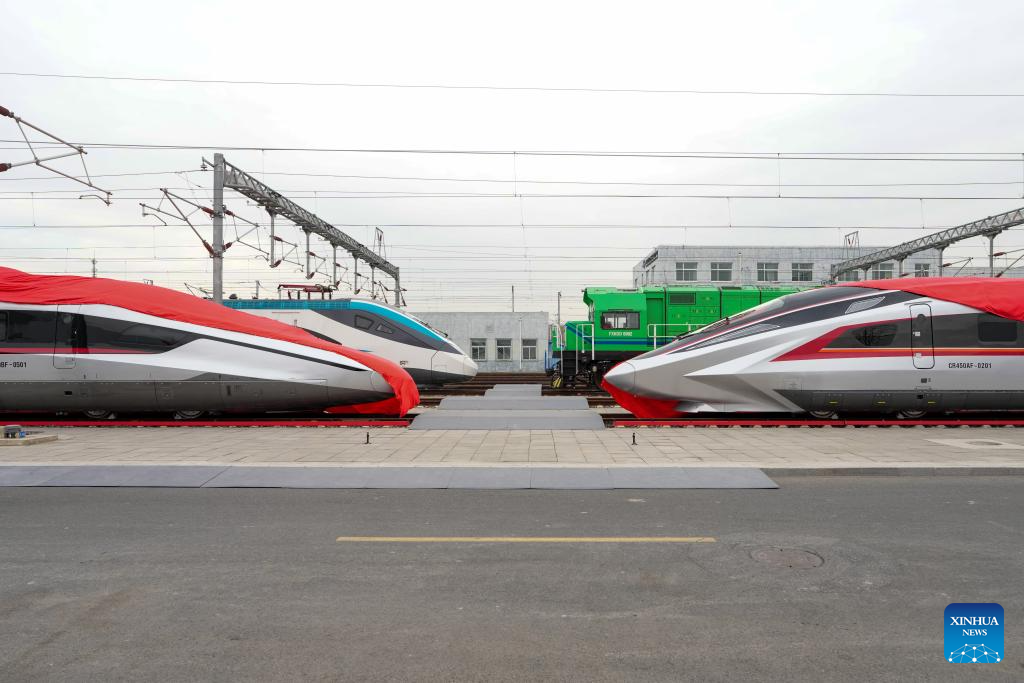
Expansion milestones
On a crisp September morning during China's Mid-Autumn Festival, Luo Wei and her family stood at Chengdu East Railway Station, excited but unsure. They were embarking on a last-minute trip to Jiuzhaigou, a picturesque UNESCO World Heritage Site nestled in the mountains of western Sichuan province. In the past, such a journey would have been an exhausting multi-day ordeal. The eight-hour road trip from Chengdu to Jiuzhaigou is notorious for its winding roads through the mountains and steep drop-offs below. But this time, they were about to board a new train service that would transform the experience.
In 1 hour and 39 minutes, they reached their destination, smoothly gliding through the mountains aboard a cutting-edge bullet train. Although a two-hour bus ride linking the railway station and the scenic area still awaits, it was much better than the previous eight-hour journey from Chengdu. No more hours spent cramped in a car on winding roads. It was a glimpse into the future of transportation in China, where high-speed rail has turned what once felt like an impossible journey into a comfortable, efficient reality.
"We thought it might be different to see Jiuzhaigou by train, especially with our 10-year-old son," Luo said, reminiscing about the challenging, fun-filled backpacking and self-driving trips she and her husband had taken several times during their school years.
"It (the train journey) was certainly easier, and the trip was far more comfortable — much more suitable for a family outing, especially with a child," she said.
"Before, a round trip to Jiuzhaigou would take at least three days. Now we can do it in just a day."
The 69-km newly opened railway from Zhengjiangguan to Huangshengguan links this remote yet breathtaking region to China's extensive railway network for the first time.
Over a century ago, Sun Yat-sen, a pioneering Chinese revolutionary leader, envisioned a modernized China in his book The International Development of China. His plan included the construction of 1.6 million km of roads and approximately 160,000 km of railways. Last year, while Sun's vision for railways became a reality, the development of China's high-speed rail has in all likelihood exceeded his expectations.
Last year, more than 3,100 km of new rail was built, including 2,457 km of high-speed rail, linking key cities and regions.
Since 2012, the total length of China's rail network has grown by more than 65 percent, while high-speed rail has expanded over fourfold.

Compared to 2012, when China's total railway length was 98,000 km with 9,356 km of high-speed rail, the country's rail infrastructure has undergone an impressive transformation.
Li Jingwei, deputy head of the development and reform department of China State Railway Group, highlighted the accelerated pace of construction.
"Since 2012, the expansion of China's high-speed rail has intensified, with an average of over 3,000 km of new high-speed rail lines put into operation annually," Li said.
Notably, China is the only country to achieve commercial operation of high-speed rail at 350 km/h, showcasing technological prowess, he said.
"From snowy forests in the northern part of China to the water towns in the eastern region, and from the desert to the sea, China's high-speed rail traverses major rivers and rugged mountains, and connects all regions," Li said.
He added that the high-speed railway network covers more than 96 percent of cities with populations over 500,000, including the Hong Kong Special Administrative Region.
By 2030, China aims to have built a world-class modern railway network covering about 180,000 km, including around 60,000 km of high-speed rail. This expansion will create a more efficient and interconnected transportation system, allowing passengers to travel between major cities in just one to three hours and ensuring the swift movement of cargo across the country.
The expansion of the network has not only reduced travel times but also increased connectivity between major cities and more isolated areas, including regions with challenging terrain, where building roads is already difficult, let alone railways. This is particularly true in the rugged mountains of Sichuan and the Xizang autonomous region, where new rail lines have brought services to remote locations, boosting regional development and tourism.
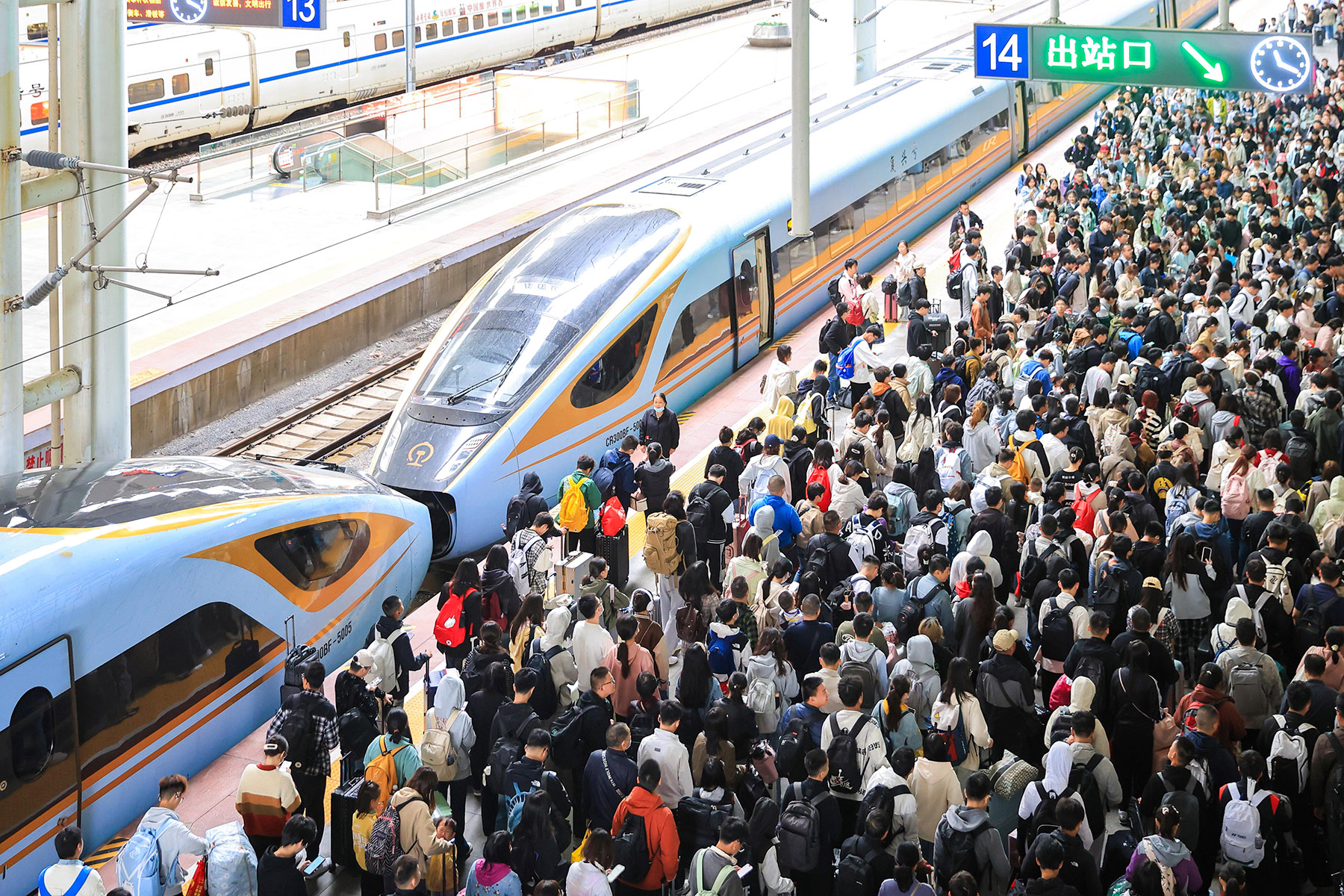
Greater access
The improvement of China's railway network has had a transformative effect on the tourism industry.
Yin Wei, head of a travel agency in Jiuzhaigou, with 12 years of experience in the industry, has witnessed dramatic changes in travel patterns over the years. He said the new rail line has had an enormous impact on tourism.
"The travel time from Chengdu to Jiuzhaigou has been greatly shortened," he said.
"Tourists have eagerly awaited this rail line, and we received a lot of inquiries," he said. "In the past, our tours typically lasted five days, but now, visitors can experience it in just one or two days."
The agency has already started developing tailored weekend getaway packages for tourists.
"Visitors can arrive on Friday and spend two days exploring Jiuzhaigou and Huanglong, or even come for a one-day trip to enjoy the snowy scenery in the morning and return by evening. It's incredibly appealing to tourists," he said.
Yin believes the easy access will benefit not only Jiuzhaigou but also the surrounding attractions, leading to an overall increase in tourism revenue for the region.
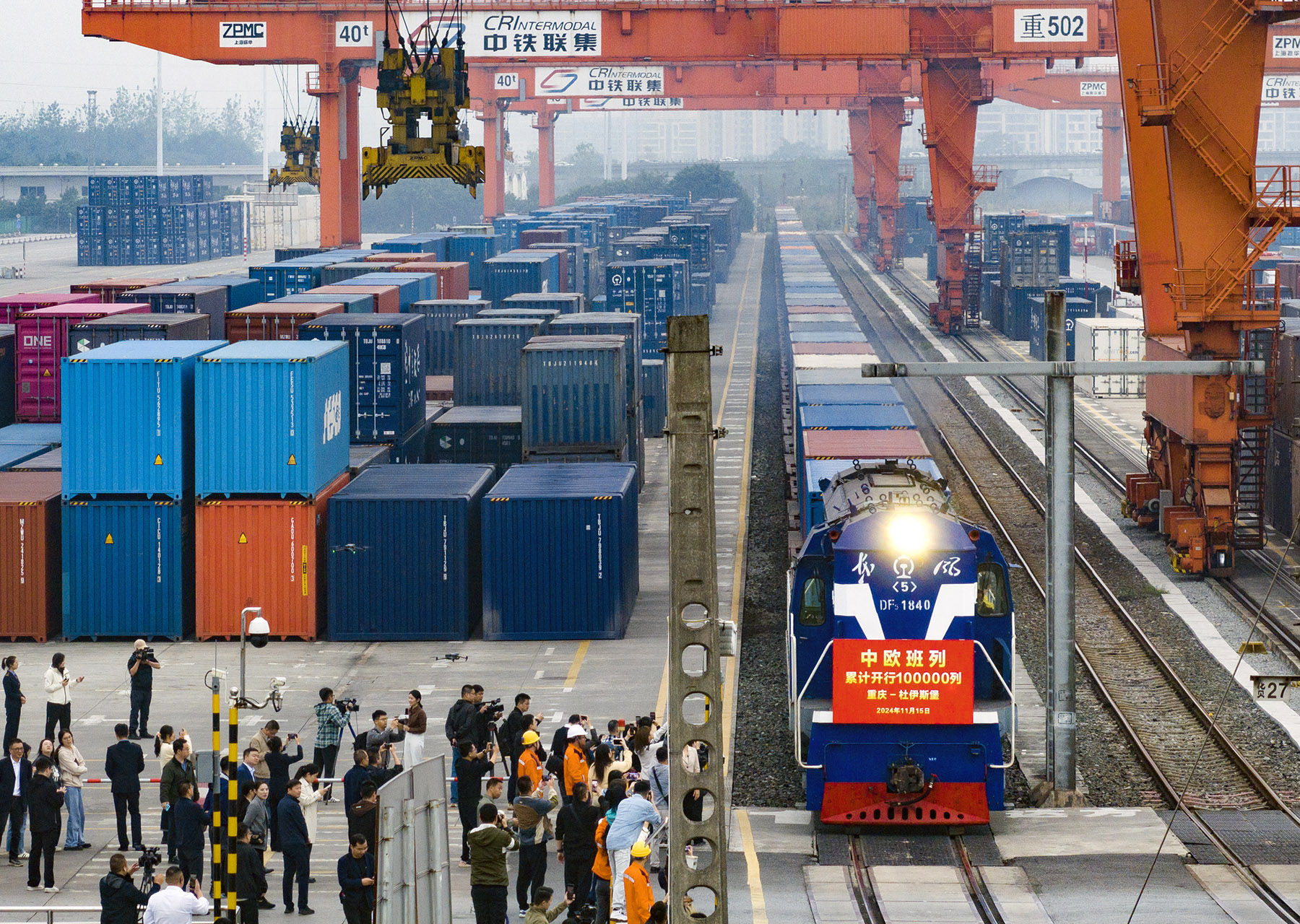
Ferrying freight
While passenger services have seen dramatic improvements, China's railway network is also revolutionizing global trade. A notable milestone was achieved on Dec 3 when freight train X8083 — carrying goods such as electronics, home appliances, auto parts and daily necessities — arrived in Duisburg, Germany, marking the 100,000th journey between China and Europe. The train, which departed from Chongqing on Nov 15, took 18 days to reach the German city.
As a cornerstone of the Belt and Road Initiative, the China-Europe freight train has evolved into a critical link for trade and connectivity, fostering open cooperation, mutual benefit and economic integration among the countries along the route.
In 2024, the service hit a significant benchmark with 19,000 China-Europe freight trains operated, transporting 2.07 million containers — an increase of 10 percent and 9 percent, respectively, compared to the previous year.
Since launching in 2011, the service has transformed global trade by enhancing connectivity between China and Europe. It has maintained a strong track record for safety, stability and efficiency, making it an indispensable component of the international logistics network.
Li Chao, deputy director of the Policy Research Office of China's National Development and Reform Commission, said: "The China-Europe freight train service is a vital carrier of open cooperation, fostering mutual benefit and supporting the Belt and Road Initiative. It provides a new, all-weather, high-capacity, green and low-carbon transport route that has become a valuable international public good."
The service is notably less affected by natural environmental factors, offering higher reliability compared to other forms of transportation. With costs just one-fifth of air freight and transit times a quarter of sea transport, the freight train has become a preferred choice for many businesses. In 2023, it accounted for over 7 percent of the total trade between China and Europe.
Over the past 13 years, the network has expanded rapidly, growing from a handful of routes into a comprehensive service covering most of the Eurasian region. Today, it connects 227 cities in 25 European countries, 100 cities in 11 Asian countries, and is continually expanding. This broadening network has significantly transformed the logistics landscape between China and Europe, offering businesses more efficient options across diverse regions.
The range of goods transported via the China-Europe freight train is also diversifying. It now handles over 50,000 types of goods across 53 categories, including automobiles, machinery, electronics and epidemic prevention materials, according to China State Railway Group, the service's operator.
The rail service has benefitted both Chinese and international consumers and businesses. For example, Zhejiang Mundiver Import & Export, a company engaged in trade with Spain, has seen significant improvements in its logistics operations. Since 2014, when the China-Europe freight train began operating from Yiwu, Zhejiang province, the company has been using the service to import goods from Europe.
Kong Zhijian, the company's marketing manager, said: "Before the rail service, we relied on sea transport, which took about 45 days and required a secondary transfer at Ningbo Port. Now, goods can be delivered directly to Yiwu from Europe in less than 20 days."
The faster transit time has helped streamline their business operations, particularly with products like wine. "This shorter shipping cycle helps us manage cash flow more effectively, which is crucial for our business," Kong added.
The impact of the rail service extends beyond China. It has also brought significant economic benefits to cities along the route. For instance, Duisburg Port has become a major logistics hub, attracting over 100 logistics companies and creating more than 20,000 jobs.
The progress of railways has always been driven by technology and innovation. In this regard, China also made remarkable strides in 2024, with faster trains now on track.
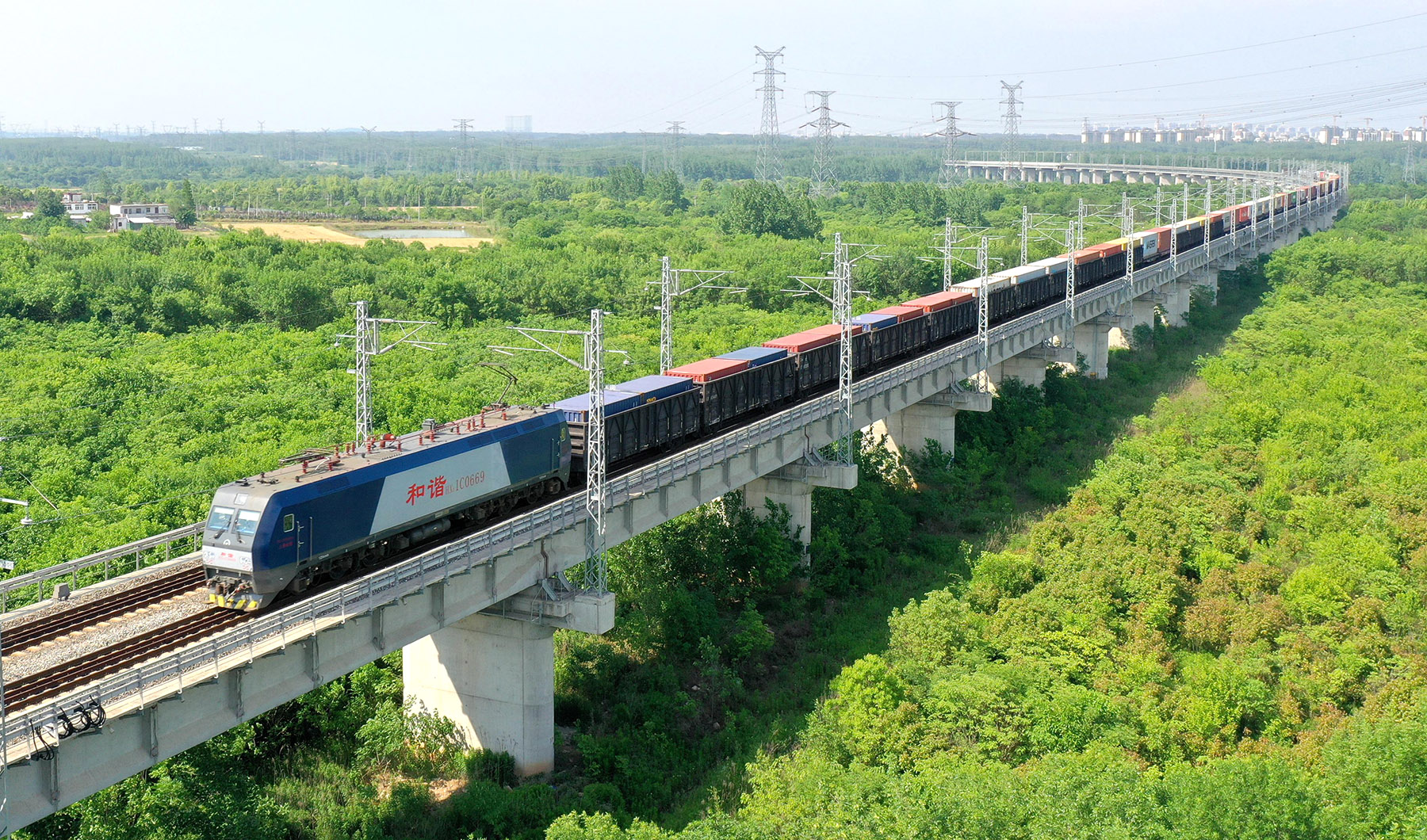
Next generation
On Dec 29, China unveiled two CR450 high-speed train prototypes, which are capable of reaching a test speed of 450 km/h and an operational speed of 400 km/h. They will be the fastest high-speed trains in the world once they enter commercial service, surpassing China's current CR400, which operates at 350 km/h.
It was one of the most exciting developments in the railway sector in 2024. This leap in speed and comfort reflects China's ongoing leadership in high-speed rail technology.
The two prototypes, with their futuristic design, have reduced weight by 10 percent to improve fuel efficiency. To decrease rolling resistance, the development team wrapped the trains' running gear — such as the wheels, axles and suspension system — partly, marking a breakthrough in railway engineering.
The interiors of the prototypes are also cutting-edge. In business class, the seats can be adjusted to a meeting mode, allowing them to be arranged face-to-face, transforming the compartment into a conference room at any time.
In economy class, the seats are ergonomically designed for greater comfort, with curves that better suit the body. In response to passenger smartphone use, small tables in economy class now feature a rack that enables passengers to prop up their phones to watch videos.
Inside the train, lighting adjusts automatically in response to the brightness outside, enhancing passenger comfort. The luggage storage areas have also been made more spacious, reducing congestion. The interior has been redesigned for greater comfort and convenience, increasing cabin space by 4 percent. Adjustable luggage racks and versatile storage areas can accommodate passengers' needs, including bicycles, wheelchairs and other large items. These upgrades anticipate potential regulatory changes in passenger transport.
Sui Fusheng, a researcher at the Institute of Acoustics at the Chinese Academy of Sciences, highlighted the challenge of balancing weight reduction with noise control. He led a team dedicated to optimizing the noise management for the prototypes.
"To reduce weight is detrimental to noise control, and increasing speed also exacerbates noise, so we have to overcome these two critical factors to ensure a comfortable passenger experience," he said.
"The results have been good; the ride experience is similar to that of the current CR400 running at 350 km/h," he added.
To balance noise control and weight reduction, the team developed integrated composite materials that offer both thermal insulation and soundproofing. These innovations not only reduce material costs and complexity but also enhance passenger comfort by effectively managing temperature and noise levels.
The team's solutions have laid the groundwork for quieter, more efficient high-speed rail travel, Sui added.
"China's high-speed rail system has made a historic leap, evolving from a follower to a global leader. Its high-speed rail technology has now set an international benchmark," said Li Yongheng, an official from China State Railway Group, referring to the development of the CR450.
"To further strengthen and expand China's leadership in high-speed rail technology, and to better support Chinese modernization, our company, together with relevant ministries, organizations, research institutes, universities and enterprises, has formed an innovative team to tackle critical technological challenges," he added.
The CR450 represents the culmination of years of innovation in high-speed rail, making it a fitting symbol of China's railway sector in 2024 — a year marked by groundbreaking achievements, record-breaking passenger and freight volumes, and a continually expanding network that links China to the rest of the world.
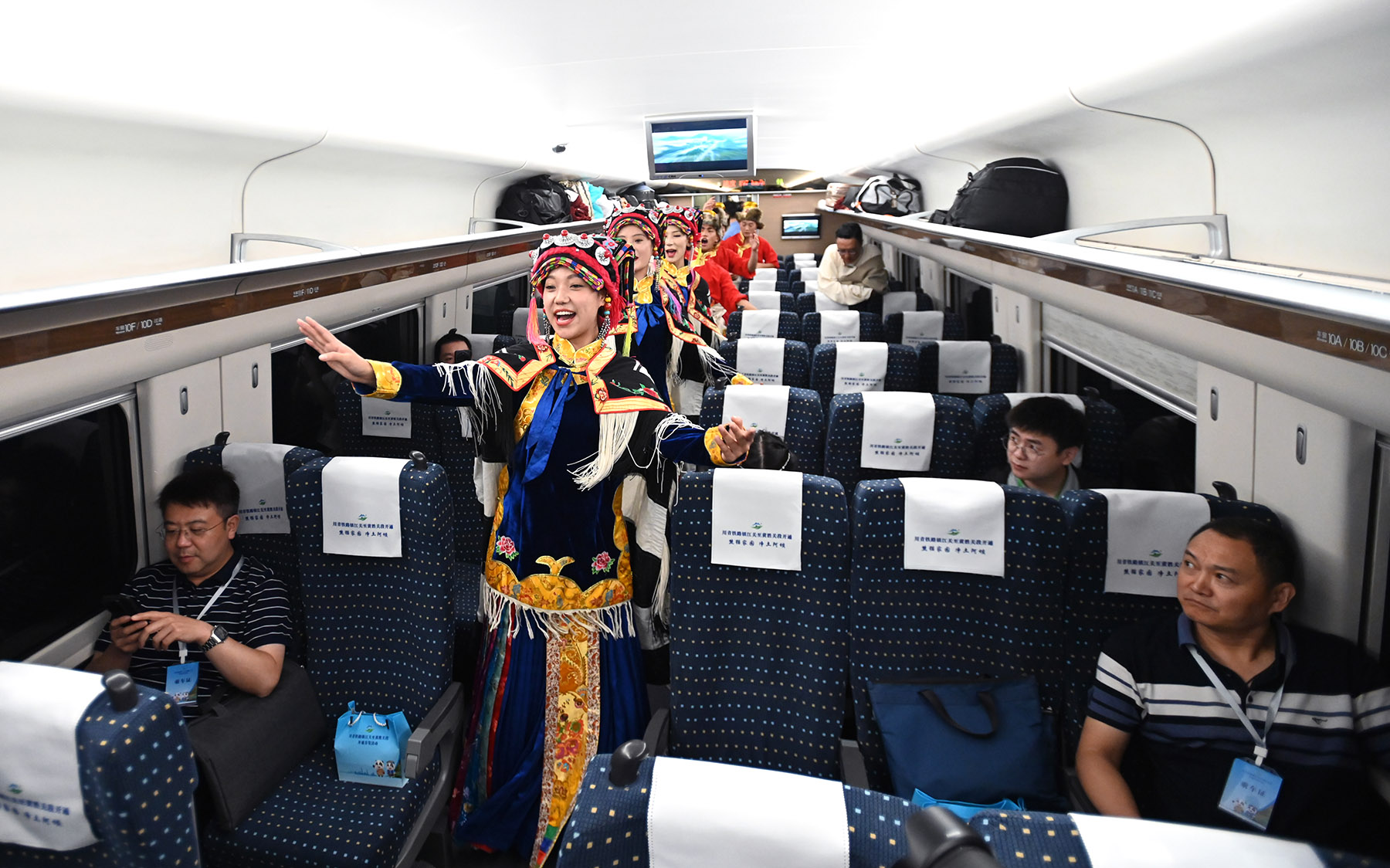
Looking ahead
These breakthroughs in railway technology are not just abstract concepts — they're transforming the way people experience travel. On that September morning, Luo Wei and her family were not just passengers on a train — they were part of a story of transformation that is reshaping the future of travel, trade and global connectivity. The ease and efficiency of their journey to Jiuzhaigou were a microcosm of the larger changes sweeping across China.
ALSO READ: China railways carry more than 200m in Spring Festival rush
As China looks ahead, its railway sector remains a symbol of the country's ambition to lead the world in technological innovation and sustainable development. With the CR450 on the horizon and a growing railway network connecting regions far and wide, China is poised to continue pushing the boundaries of what's possible in transportation. And with it, the world will continue to move faster, more efficiently and more sustainably.
For Luo Wei and countless others, the high-speed rail of 2024 is a journey into tomorrow — one that is already well underway.
Peng Chao in Chengdu contributed to this story.


